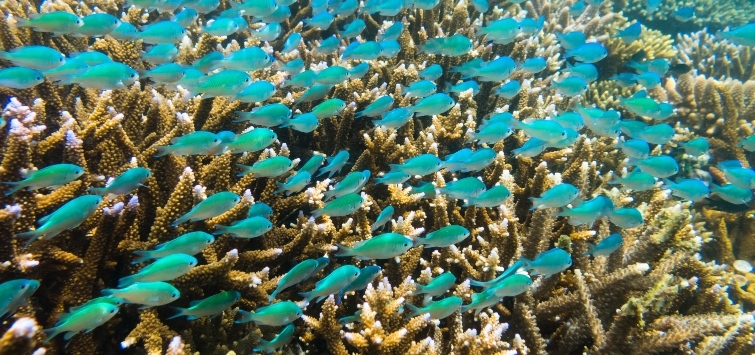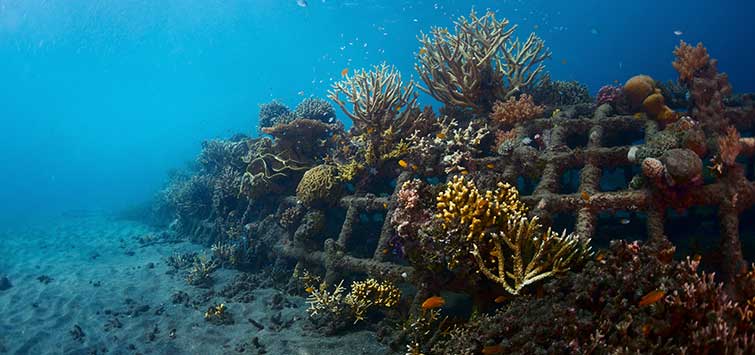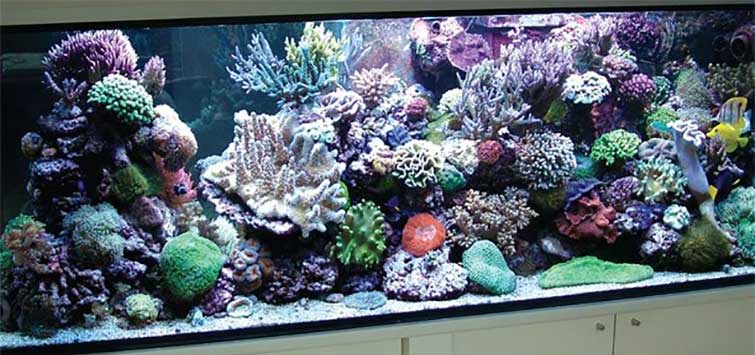Architects of the Reef
Author: Francesco Ricciardi
Hard corals form the backbone of any reef and come in a diverse array of shapes, sizes, and colors. An avid diver takes a look at what corals offer and the challenges that they face.
Hard Corals
Hard corals are the most important reef builders in tropical areas. Their presence is a guarantee of biodiversity protection, ecological balance, and a source of life and sustenance for many coastal human populations. Total protection and sustainable harvesting of coral reefs, together with sustainable hard coral aquaculture, are necessary measures to preserve these incredible ecosystems.
One of the most incredible natural wonders is below the surface of the sea: Tiny animals, from 1 to 3 mm long, are able to build amazing structures and colonies extending for thousands of kilometers, the tropical coral reefs. Known as scleractinians among scientists, the hard (or stony) corals are widespread along tropical areas worldwide, from north Australia—where the Great Barrier Reef, the largest coral reef in the world, is—to Indo-Pacific waters (Indonesia, Malaysia, Philippines), to Africa and the Caribbean Sea. Coral reefs are normally found in shallow areas with a temperature at least above 20°C (68°F) but below 30°C (86°F), clear water, little sedimentation, salinity around 36 parts per thousand, and strong light.
Amazing Biodiversity
Identifying an individual hard coral species is a very tough task, both in the wild and in the aquarium. Most of the differences among species are detectable only by observing the skeletal microstructures of the animal. For this reason, probably many new species of hard corals are waiting to be discovered: At the moment, the hotspot of biodiversity is located in the Coral Triangle area (Indonesia, Malaysia, and the Philippines) with approximately 500 single species grouped in almost 30 families. Scientists estimate that, nowadays, a total of about 1,300 species of hard corals are officially described. Some of the most famous hard corals in the aquarium trade include the genera Acropora, Montipora, and Pocillopora.
Depending on the location on the reef (internal or external) and the sea conditions (presence of current, waves, etc.), the growth of hard corals may differ. Branched forms, like many Acropora spp., prefer sheltered areas, while flattened or massive forms, like Porites, are prevalent in areas with strong water movement.
Simplicity Behind Complexity
The basis of the enormous complexity of shapes and growths of stony corals is a small, quite primitive animal called a polyp. Basically, the polyp is a cylindrical sac, attached to the substrate, with a mouth surrounded by tentacles that the animal uses to collect food. Stony corals used in aquaria are usually described as SPS (small-polyp stony corals) and LPS (large-polyp stony corals), depending on the size of the coral polyps.
Despite this apparent simplicity, many of the anatomical and biological features of the polyps are amazing.
The symbiosis of some corals with zooxanthellae, microscopic algae that use the light to produce organic matter, allows the polyps to grow very fast—up to 10 cm (4 inches) per year for some branching corals. Corals with zooxanthellae live in clear and shallow waters and are easily distinguishable from the other species by observing the color, normally greenish-beige due to the presence of these algae. When the light is not present, like during the night, the polyps emerge from their holes in the carbonate skeleton and open tentacles to collect the food brought by the currents.
Thanks to this double source of food (light and plankton), these corals are able to deposit calcium carbonate—the basis of the skeleton of hard coral colonies—much faster than other reef-builder organisms, and over the geological eras they have been able to build incredible formations like the Australian Great Barrier Reef, extending more than 2600 km (1600 miles).
The Hard Life of a Coral
Hard corals have a very important role in tropical reef ecosystems. They are shelter for thousands of different species of vertebrates and invertebrates, and serve as food for a large number of fish (corallivores) like many in the butterflyfish family, which has some species that are exclusive coral feeders. In some areas of the tropical Indo-Pacific, explosive growth in the population of the crown-of-thorns starfish (Acanthaster planci), which isable to eat large amounts of coral polyps, has caused the destruction of wide coral reef areas.
Competition
Interspecific competition is also a big issue for hard corals. Colonies contend with one another for access to sunlight, and the war for physical space on a crowded tropical reef is incredibly intense, but also slow. Not only do corals compete for space, but so do coralline algae, sponges, and many other invertebrates, like bryozoans. And, of course, parasites, viruses, and other kinds of diseases contribute to the tough life of hard-coral colonies.
Man-Induced Threats
Man-induced threats, like organic pollution and global climate change, are becoming the main threats to the survival of hard corals. The change in ocean acidity due to increased CO2 is shifting the equilibrium of calcium carbonate deposition, and many coral colonies—especially those living in colder areas—are not able to tolerate the change, so their rate of deposition and growth could be dramatically reduced.
Bleaching
Coral bleaching is a natural phenomenon that occurs in some corals and anemones when the water temperature gets too high and their symbiotic zooxanthellae begin to produce toxins. When this happens, the “enemy within” must be eliminated, so the zooxanthellae are expelled. Sadly famous is the massive coral bleaching induced by El NiÑo in the 1990s, especially in the Indian Ocean. Other coral-bleaching events have been recorded worldwide, including on the Great Barrier Reef and in the Indo-Pacific area (Indonesia, Malaysia, Philippines). Some of these areas are showing signs of recovering, but the increasing temperature remains a critical threat for every coral reef.
Sedimentation
Sedimentation and organic runoff are destroying many reef areasadjacent to big cities or where coastal development is reducing the mangrove foreststhat normally keep sedimentation low and protect coasts from erosion.
Dynamite and Cyanide Fishing
In some remote areas of the Indo-Pacific, like Indonesia and the Philippines, dynamite and cyanide fishing have destroyed large parts of the reef. Even if these practices are officially forbidden worldwide, when diving in remote areas, it’s not uncommon to hear explosions or to find areas where many little fish are dying, intoxicated by cyanide.
Rays of Hope
In many areas of the world, the aquaculture of hard corals is gaining popularity and efficacy. Cultivated hard corals can be used to replenish damaged reefs and are regularly sold to and traded among aquarium enthusiasts who wish to have a piece of the coral reef at home. Recent experiments have demonstrated that in some conditions, hard corals can grow fast enough to satisfy the aquarium market and to serve as a source of renewable income for coastal populations that are beginning to understand that the protection of their natural resources is necessary for their survival and wealth. And aquarium enthusiasts can play a big part in promoting the development of sustainable sources of marine life.
See the full article on TFH Digital http://www.tfhdigital.com/tfh/201304#pg93

.png?h=595&iar=0&w=2781&hash=5FD5E69473BCC22199FBFA2FB71B6033)



